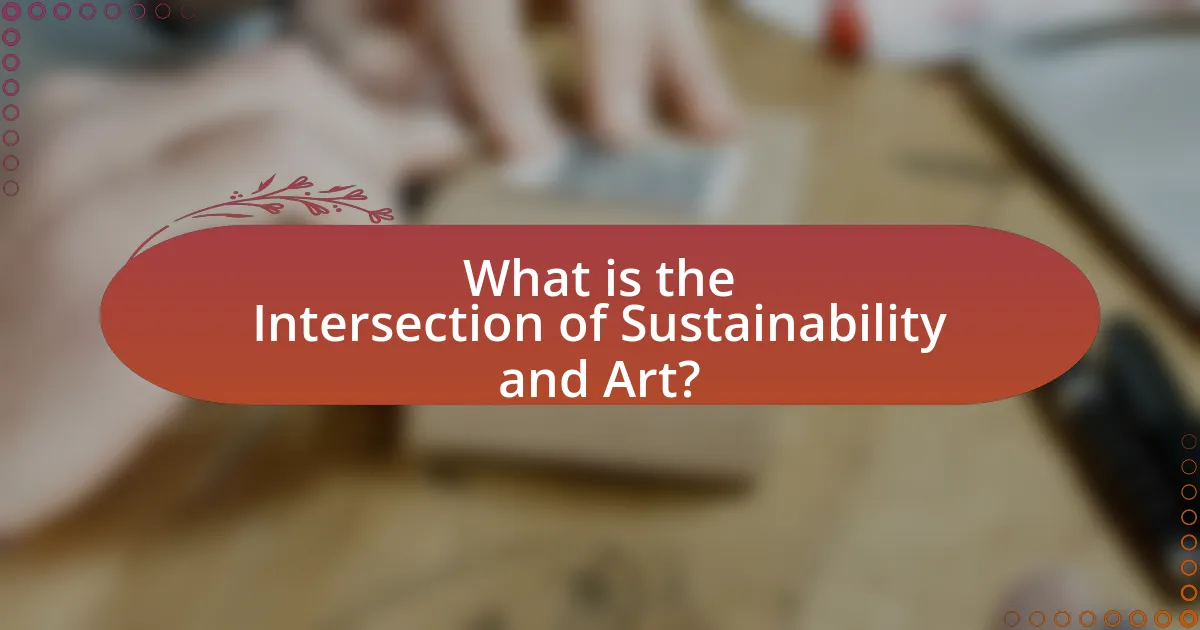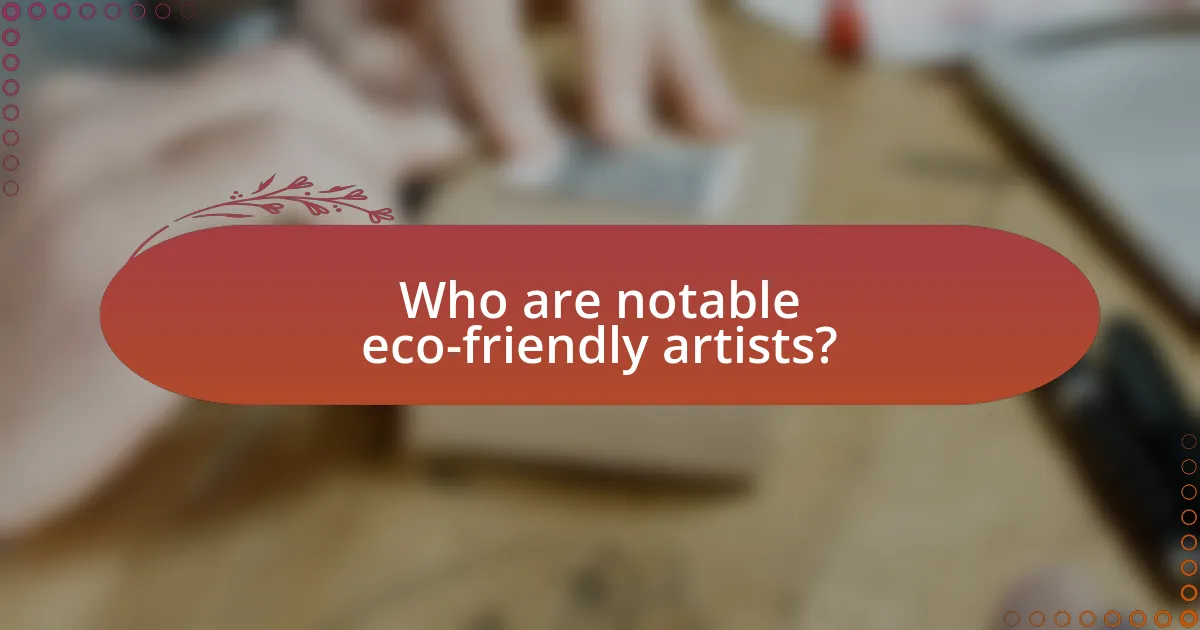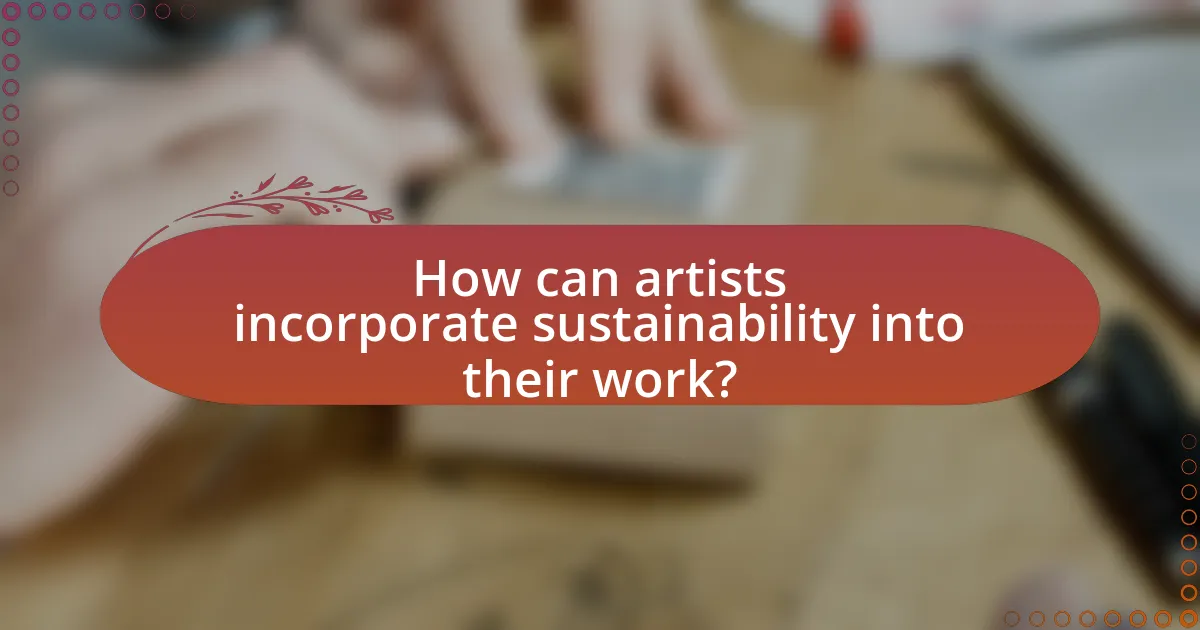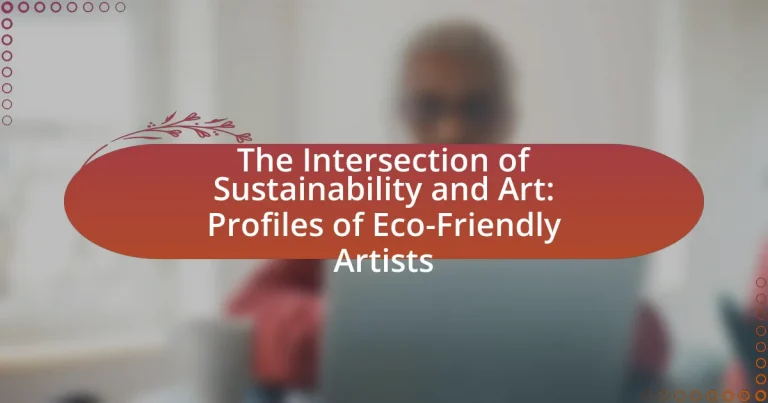The article explores the intersection of sustainability and art, highlighting how artists integrate eco-friendly practices and materials into their work to raise awareness about environmental issues. It discusses the influence of sustainability on artistic expression, key principles of eco-friendly art, and notable artists who advocate for ecological responsibility. Additionally, the article examines how art serves as a medium for environmental awareness, the role of eco-friendly art in combating climate change, and practical steps artists can take to enhance their sustainable practices. Through profiles of prominent eco-friendly artists and their impactful works, the article underscores the importance of art in promoting sustainability and inspiring social change.

What is the Intersection of Sustainability and Art?
The intersection of sustainability and art involves the integration of eco-friendly practices and themes into artistic expression. Artists increasingly utilize sustainable materials, such as recycled or biodegradable substances, to create works that raise awareness about environmental issues. For example, the use of reclaimed wood or plastic waste in sculptures not only reduces environmental impact but also conveys messages about consumption and waste. This approach aligns with the growing movement in contemporary art that seeks to address climate change and promote ecological responsibility, as evidenced by initiatives like the “EcoArt Network,” which connects artists focused on environmental themes.
How do sustainability and art influence each other?
Sustainability and art influence each other by promoting awareness and inspiring action towards environmental issues through creative expression. Artists often utilize sustainable materials and practices, which not only reduce environmental impact but also convey powerful messages about conservation and ecological responsibility. For instance, the use of recycled materials in artworks can highlight waste reduction, while installations that engage with natural landscapes can foster a deeper connection between viewers and their environment. This relationship is evident in movements such as eco-art, where artists like Andy Goldsworthy create site-specific works that emphasize the beauty of nature and the importance of preserving it. Such artistic endeavors not only raise public consciousness about sustainability but also encourage individuals and communities to adopt more eco-friendly practices.
What are the key principles of sustainability in art?
The key principles of sustainability in art include the use of eco-friendly materials, minimizing waste, and promoting social responsibility. Eco-friendly materials, such as recycled or biodegradable substances, reduce environmental impact and resource depletion. Minimizing waste involves creating art that utilizes leftover materials or encourages reuse, thereby decreasing landfill contributions. Promoting social responsibility encompasses raising awareness about environmental issues through art, fostering community engagement, and supporting ethical practices in the art industry. These principles collectively aim to create a more sustainable art practice that aligns with broader environmental goals.
How does art serve as a medium for environmental awareness?
Art serves as a medium for environmental awareness by visually communicating ecological issues and inspiring action. Through various forms such as installations, paintings, and performances, artists highlight the impact of climate change, pollution, and habitat destruction. For instance, the work of artists like Olafur Eliasson, who creates immersive installations that reflect on climate change, engages audiences emotionally and intellectually, prompting them to consider their relationship with the environment. Additionally, studies show that art can evoke empathy and motivate behavioral change; a report by the National Endowment for the Arts indicates that art can enhance public understanding of complex issues, making it a powerful tool for advocacy and education in environmental sustainability.
Why is eco-friendly art important in today’s society?
Eco-friendly art is important in today’s society because it promotes environmental awareness and sustainability through creative expression. This form of art utilizes sustainable materials and practices, reducing waste and pollution while encouraging a dialogue about ecological issues. For instance, artists like Chris Jordan use their work to highlight the impact of consumerism on the environment, effectively raising awareness about plastic pollution. Furthermore, a study by the American Alliance of Museums found that 70% of museums are prioritizing sustainability in their operations, indicating a growing recognition of the importance of eco-friendly practices in the arts. This shift not only fosters a culture of responsibility but also inspires individuals and communities to engage in sustainable practices, making eco-friendly art a vital component of contemporary societal values.
What role does eco-friendly art play in combating climate change?
Eco-friendly art plays a significant role in combating climate change by raising awareness and promoting sustainable practices. Artists utilize environmentally friendly materials and methods, which not only reduce waste but also inspire audiences to consider their own environmental impact. For instance, the use of recycled materials in art installations can highlight the importance of recycling and resource conservation. Additionally, eco-friendly art often addresses climate-related themes, encouraging public discourse and action on environmental issues. Studies have shown that art can effectively influence public perception and behavior regarding climate change, making it a powerful tool for advocacy and education.
How can eco-friendly art inspire social change?
Eco-friendly art can inspire social change by raising awareness about environmental issues and promoting sustainable practices. Artists who utilize recycled materials or themes of nature in their work often engage audiences in conversations about climate change, pollution, and conservation. For instance, the work of artist Chris Jordan, who creates large-scale images from consumer waste, visually communicates the impact of overconsumption, prompting viewers to reconsider their habits. Additionally, initiatives like the “Art for the Earth” project demonstrate how art can mobilize communities around environmental activism, leading to tangible actions such as clean-up events and policy advocacy. These examples illustrate that eco-friendly art not only serves as a medium for expression but also acts as a catalyst for societal transformation towards sustainability.

Who are notable eco-friendly artists?
Notable eco-friendly artists include Olafur Eliasson, who creates immersive installations that raise awareness about climate change, and Agnes Meyer-Brandis, known for her work that explores the relationship between humans and nature. Additionally, Chris Jordan uses photography to highlight consumerism’s impact on the environment, while Maya Lin integrates natural elements into her architectural designs to promote ecological awareness. These artists utilize their platforms to advocate for sustainability and inspire action against environmental issues.
What are the backgrounds of prominent eco-friendly artists?
Prominent eco-friendly artists often come from diverse backgrounds that influence their artistic practices and commitment to sustainability. Many have formal education in fine arts, environmental science, or design, which shapes their understanding of ecological issues. For instance, artists like Olafur Eliasson, who studied at the Royal Danish Academy of Fine Arts, incorporate environmental themes into their work, using materials that reflect their commitment to sustainability. Similarly, Agnes Meyer-Brandis, with a background in art and cultural studies, focuses on the relationship between humans and nature in her projects. These educational foundations, combined with personal experiences and a passion for environmental advocacy, drive their artistic expressions and innovative approaches to eco-friendly art.
How did their personal experiences shape their artistic practices?
Personal experiences significantly shaped the artistic practices of eco-friendly artists by influencing their perspectives on environmental issues. For instance, many artists draw inspiration from their childhood experiences in nature, which instills a deep appreciation for the environment and motivates them to address ecological concerns through their work. Additionally, personal encounters with environmental degradation, such as witnessing pollution or habitat loss, often propel artists to create pieces that raise awareness and advocate for sustainability. This connection between personal history and artistic expression is evident in the works of artists like Olafur Eliasson, whose installations often reflect his upbringing in Iceland, emphasizing the beauty and fragility of nature. Such experiences not only inform their thematic choices but also dictate the materials and methods they use, often leading to the incorporation of recycled or sustainable materials in their art.
What materials and techniques do they use to promote sustainability?
Eco-friendly artists promote sustainability by using recycled materials and natural pigments. They often incorporate items like reclaimed wood, repurposed textiles, and biodegradable substances into their artwork. Techniques such as upcycling, where discarded materials are transformed into new art pieces, and using non-toxic, plant-based paints further enhance their commitment to environmental responsibility. For instance, artists like Chris Jordan utilize recycled plastic to create impactful installations that raise awareness about waste. This approach not only reduces environmental impact but also encourages viewers to reconsider their consumption habits.
What are the most impactful works by eco-friendly artists?
The most impactful works by eco-friendly artists include “The Ocean Cleanup” by Boyan Slat, which aims to remove plastic from the oceans, and “The Greenhouse” by artist and architect David Benjamin, which explores sustainable architecture. Additionally, Olafur Eliasson’s “Ice Watch” features large blocks of ice placed in public spaces to raise awareness about climate change. These works are significant as they not only engage the public but also address pressing environmental issues, demonstrating the power of art in promoting sustainability.
How do these works convey messages about sustainability?
These works convey messages about sustainability by utilizing eco-friendly materials and themes that highlight environmental issues. Artists often incorporate recycled or natural materials, demonstrating a commitment to reducing waste and promoting resource conservation. For instance, the use of reclaimed wood or biodegradable substances in sculptures not only minimizes environmental impact but also serves as a visual representation of the importance of reusing resources. Additionally, many artworks address themes such as climate change, biodiversity loss, and the impact of pollution, effectively raising awareness and prompting viewers to consider their own environmental footprints. This approach aligns with the principles of sustainability, as it encourages a dialogue about ecological responsibility and inspires action towards a more sustainable future.
What reactions have these works elicited from the public and critics?
The works of eco-friendly artists have elicited a range of positive reactions from both the public and critics, often praised for their innovative approaches to sustainability. Critics have highlighted the ability of these artists to raise awareness about environmental issues through engaging and thought-provoking art, with many noting that the integration of sustainable practices into their work resonates deeply with audiences. For instance, exhibitions featuring eco-art have attracted significant attendance, indicating strong public interest and support. Additionally, reviews in art publications frequently commend the aesthetic quality and conceptual depth of these works, reinforcing their impact on contemporary art discourse.

How can artists incorporate sustainability into their work?
Artists can incorporate sustainability into their work by using eco-friendly materials and practices. This includes selecting non-toxic paints, recycled or upcycled materials, and sustainable sourcing for their supplies. For instance, artists like El Anatsui utilize discarded materials to create large-scale installations, demonstrating how waste can be transformed into art. Additionally, artists can adopt practices such as reducing energy consumption during the creation process and promoting environmental awareness through their themes and messages. This approach not only minimizes their ecological footprint but also engages audiences in conversations about sustainability.
What are practical steps for artists to create eco-friendly art?
Artists can create eco-friendly art by using sustainable materials, minimizing waste, and adopting environmentally conscious practices. To achieve this, artists should select non-toxic, biodegradable, or recycled materials for their artwork, such as natural pigments, reclaimed wood, or recycled paper. Additionally, they can implement techniques that reduce waste, like using leftover materials from previous projects or creating art that can be easily disassembled and recycled. Furthermore, artists can consider their energy consumption by utilizing renewable energy sources, such as solar power, in their studios. These practices not only contribute to environmental sustainability but also align with the growing demand for eco-conscious art, as evidenced by the increasing popularity of eco-friendly art exhibitions and initiatives.
What sustainable materials can artists use in their creations?
Artists can use sustainable materials such as recycled paper, bamboo, organic cotton, and natural dyes in their creations. Recycled paper reduces waste and utilizes existing resources, while bamboo is a fast-growing plant that requires minimal resources to cultivate. Organic cotton is grown without harmful pesticides, making it a safer choice for the environment. Natural dyes, derived from plants and minerals, offer a non-toxic alternative to synthetic dyes. These materials not only minimize environmental impact but also promote a circular economy in the art world.
How can artists reduce waste in their artistic processes?
Artists can reduce waste in their artistic processes by utilizing sustainable materials and practices. For instance, they can opt for recycled or upcycled materials, which minimizes the demand for new resources and reduces landfill contributions. Additionally, artists can implement techniques such as digital art, which eliminates physical waste associated with traditional mediums. Research indicates that the art industry generates significant waste, with a study by the National Endowment for the Arts highlighting that sustainable practices can significantly decrease environmental impact. By adopting these methods, artists not only contribute to sustainability but also inspire others in the creative community to follow suit.
What resources are available for artists interested in sustainability?
Artists interested in sustainability can access various resources, including organizations, grants, and educational programs. Notable organizations such as the Center for Sustainable Practice in the Arts provide tools and networking opportunities for artists focused on eco-friendly practices. Additionally, grants like the Sustainable Arts Foundation offer financial support specifically for artists working on sustainability-related projects. Educational programs, such as those offered by universities with sustainability-focused art curricula, equip artists with knowledge and skills to integrate sustainable practices into their work. These resources collectively support artists in their pursuit of environmentally conscious art.
Which organizations support eco-friendly artists and initiatives?
Organizations that support eco-friendly artists and initiatives include the Creative Climate Awards, which recognizes artists addressing climate change through their work, and the EcoArts Foundation, which promotes environmental awareness through art. Additionally, the Art for the Earth initiative encourages artists to create works that inspire ecological stewardship. These organizations provide platforms, funding, and resources to artists committed to sustainability, thereby fostering a community focused on environmental issues through artistic expression.
How can artists connect with like-minded individuals and communities?
Artists can connect with like-minded individuals and communities by participating in online platforms and local events focused on sustainability and eco-friendly practices. Engaging in social media groups, attending workshops, and joining art collectives dedicated to environmental themes fosters collaboration and networking opportunities. Research indicates that artists who actively engage in community events and online forums related to their interests are more likely to build meaningful connections, as these platforms provide spaces for sharing ideas and resources.
What are the future trends in eco-friendly art?
Future trends in eco-friendly art include the increased use of sustainable materials, digital art forms, and community engagement initiatives. Artists are increasingly opting for biodegradable, recycled, or upcycled materials to minimize environmental impact, reflecting a growing awareness of sustainability. Additionally, the rise of digital art reduces the need for physical materials, further decreasing waste. Community engagement is also becoming prominent, with artists collaborating with local communities to create art that raises awareness about environmental issues, fostering a collective responsibility towards sustainability. These trends are supported by the increasing demand for environmentally conscious practices in various sectors, including art, as consumers and institutions prioritize sustainability.
How is technology influencing sustainable art practices?
Technology is significantly influencing sustainable art practices by enabling artists to utilize eco-friendly materials and innovative techniques. For instance, digital tools allow artists to create virtual art, reducing the need for physical materials and minimizing waste. Additionally, advancements in 3D printing technology enable the use of recycled materials, promoting sustainability in the production process. Research indicates that artists employing digital platforms can reach wider audiences without the environmental impact associated with traditional exhibitions, thus fostering a more sustainable art ecosystem.
What emerging movements are shaping the future of eco-friendly art?
Emerging movements shaping the future of eco-friendly art include the use of biodegradable materials, upcycling, and community-based art initiatives. Biodegradable materials, such as plant-based plastics and organic pigments, are gaining traction as artists seek sustainable alternatives to traditional art supplies. Upcycling, which involves transforming waste materials into art, promotes environmental awareness and reduces landfill waste. Community-based art initiatives engage local populations in environmental projects, fostering a collective responsibility towards sustainability. These movements reflect a growing commitment within the art community to address climate change and promote ecological stewardship.
What tips can artists follow to enhance their eco-friendly practices?
Artists can enhance their eco-friendly practices by utilizing sustainable materials, such as organic paints and recycled canvases. By choosing non-toxic, biodegradable, or sustainably sourced materials, artists reduce their environmental impact. For instance, using water-based paints instead of solvent-based ones minimizes harmful emissions. Additionally, artists can implement waste reduction strategies, like reusing scraps and donating unused supplies, which contributes to a circular economy. Research indicates that adopting these practices not only benefits the environment but also resonates with consumers increasingly interested in sustainability, as evidenced by a 2021 survey showing that 70% of art buyers prefer eco-conscious artists.




